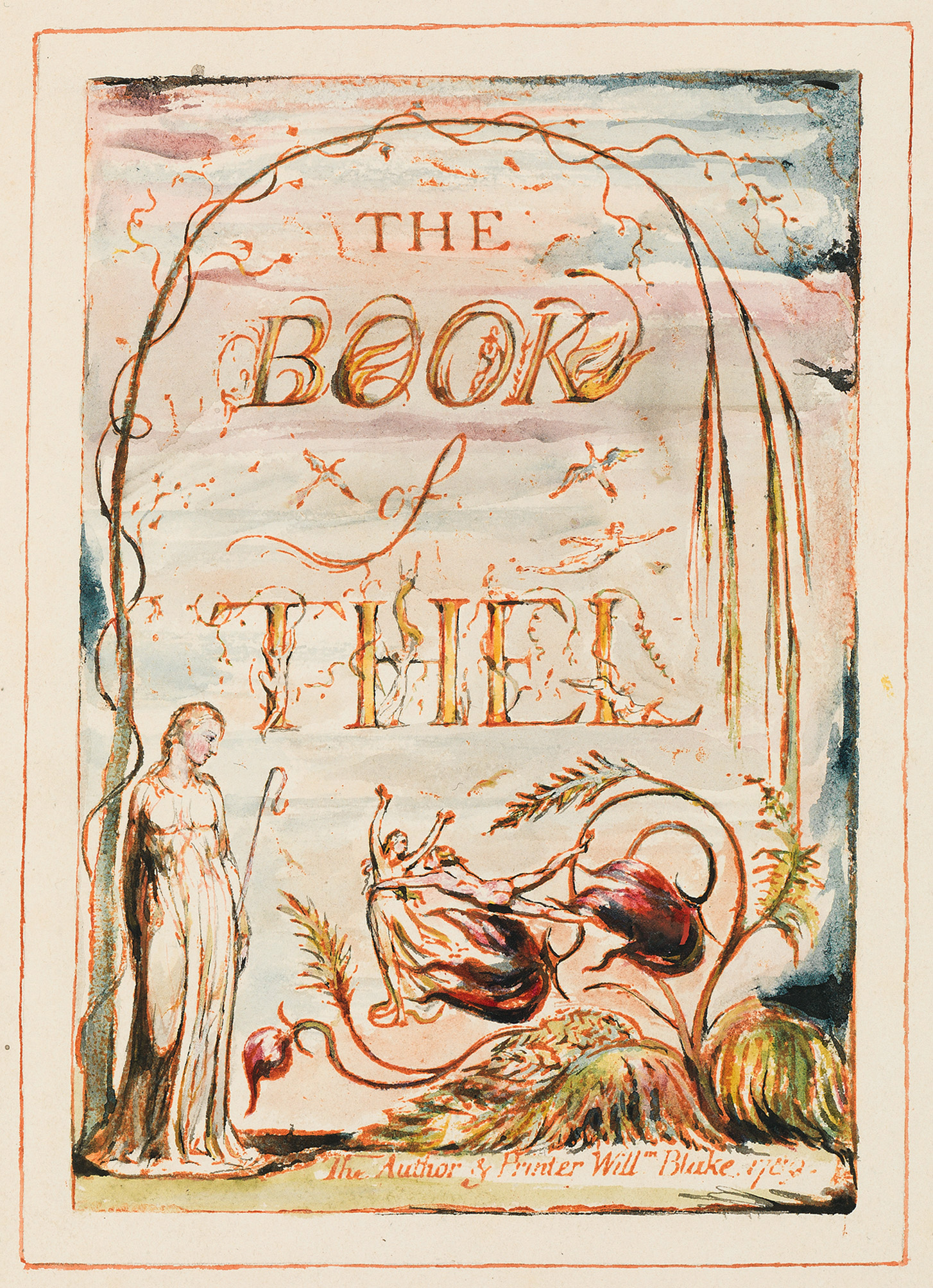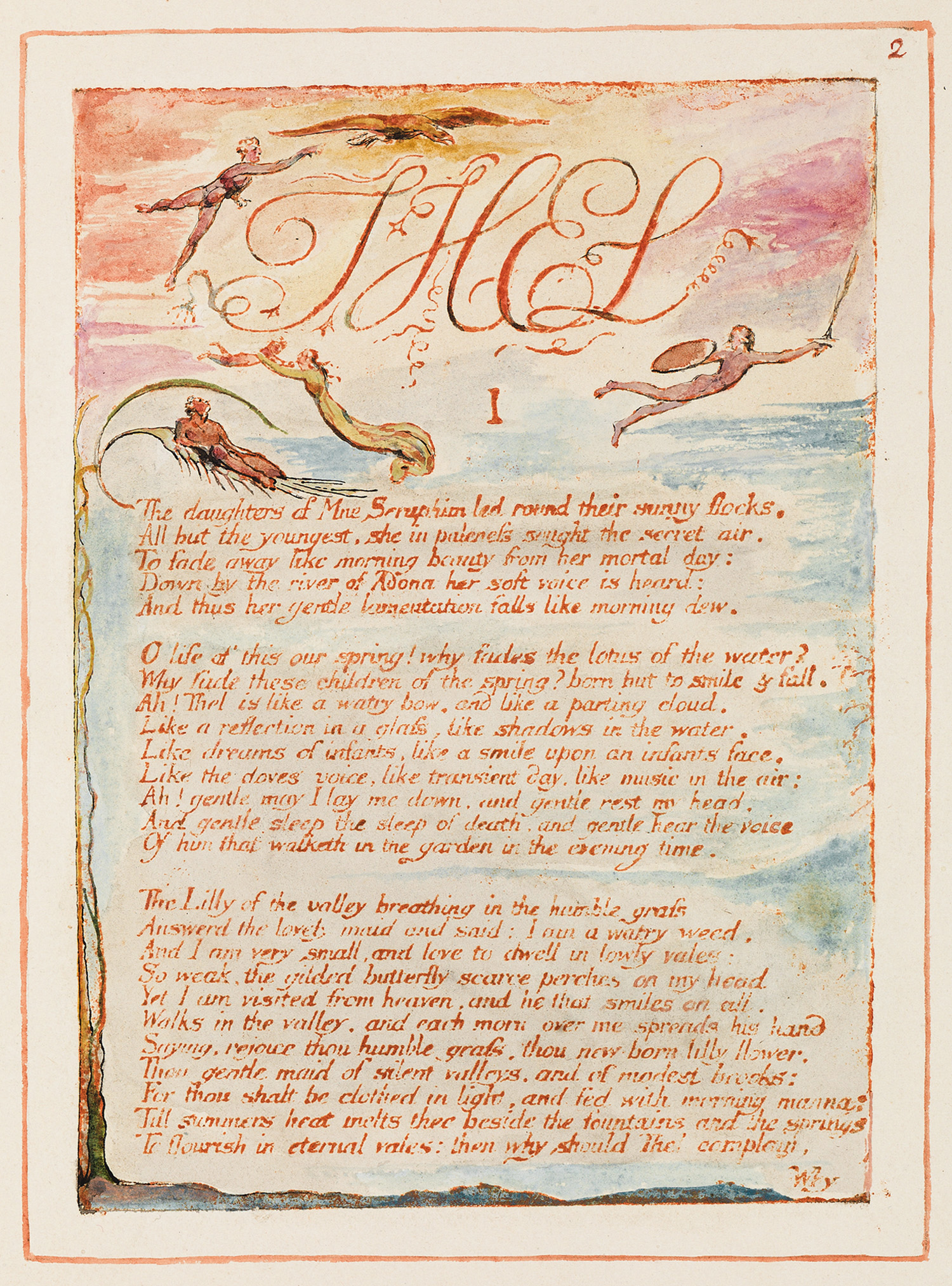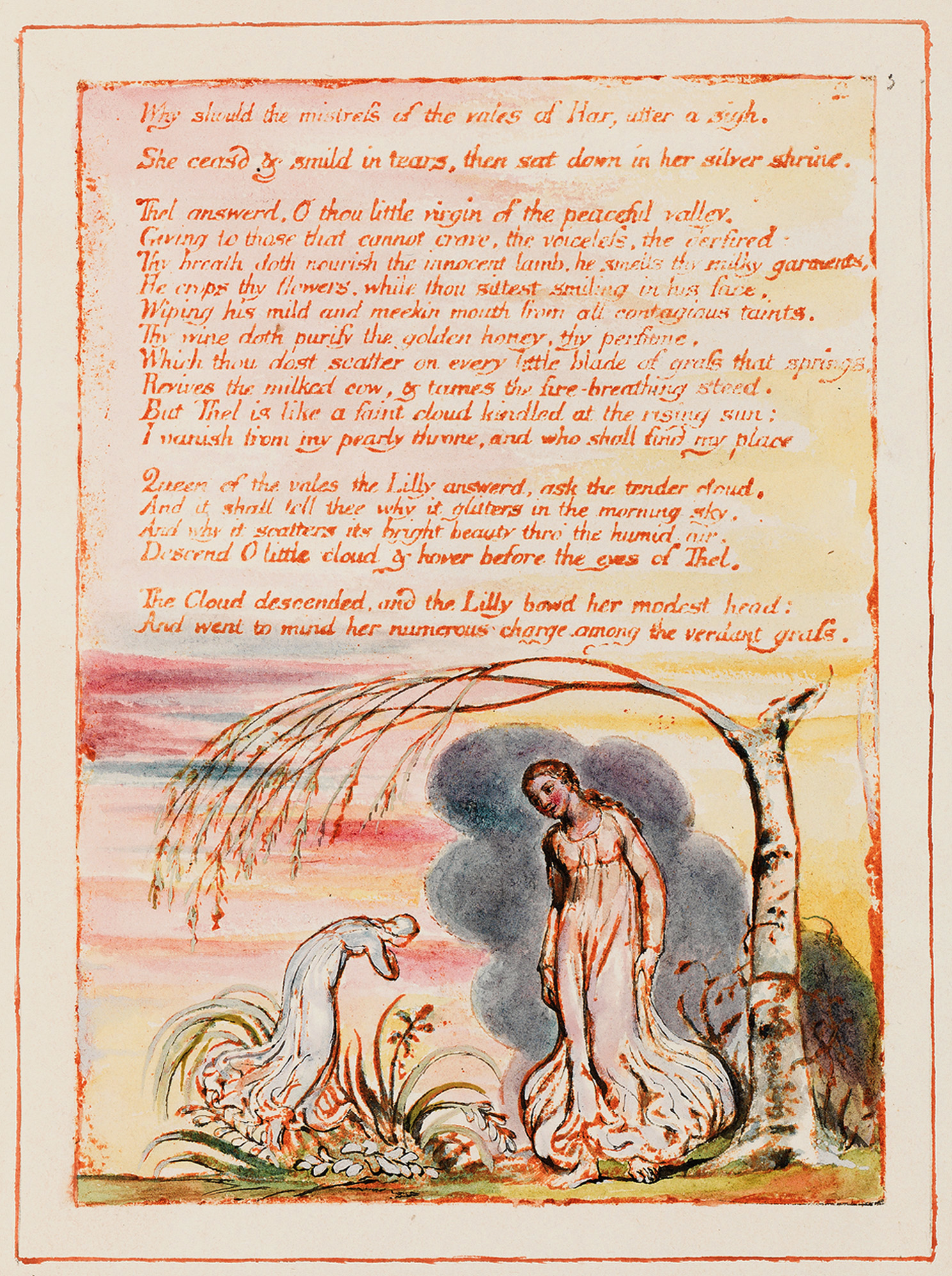note
Illuminated Books in the Cincinnati Art Museum
begin page 41 | ↑ back to topUntil the forthcoming Bentley Census appears, it is helpful to get information about the present location of illuminated books listed as untraced or as privately owned in the Keynes-Wolf Census. Whether any particular location is desirable could be debated. If the most important consideration were accessibility of at least one Blake original to the largest number of people in the widest possible area, all should rejoice to hear that an illuminated book has found a home outside one of the well-known Blake repositories. But given the practical necessity of arranging to study several works during a single research trip, as well as the importance of comparing more than one copy of the same work, the scholar may find himself hoping that a sale or a bequest will send a book to one of the great public collections where Blake’s works are already concentrated. Happily, democratic and scholarly interests are not always at odds: an account of the holdings of the Cincinnati Art Museum contains good news for everyone. Somewhat remote from other Blake collections but worth an excursion from anywhere, Cincinnati has an exquisite Thel, a long-untraced Songs of Innocence, and a closely contemporary Songs of Innocence and of Experience.
Nancy Bogen, ed., William Blake, The Book of Thel: A Facsimile and a Critical Text (Providence and New York, 1971), notes that Thel copy N is now in the Cincinnati collection (accession number 1969.510—as the gift of John J. Emery). Since Bogen’s color descriptions are sometimes unreliable, one should consult the Keynes-Wolf Census for an idea of the brilliance of this copy. Only the Rosenwald copy O, on which the Blake Trust Facsimile is based, is a Thel of comparable magnificence, though in quieter and calmer tones. If a facsimile of copy N were made by the Trianon Press—or even if it were as well reproduced as the Dent volumes—we would have a clearer idea of the power and range of Blake’s coloring. These intimately related copies differ strikingly: both sumptuously painted in Blake’s later style, both done on Ruse & Turners paper watermarked 1815, copy N is impressive for its splendor, copy O for its refinement. Added details also vary: copy N has more birds, water, and peculiar cloud effects; copy O more trees and roots [see illus.].
But on-the-spot comparison of originals is obviously a far better method of study than comparison of notes and facsimiles, and the Cincinnati Art Museum also affords an opportunity for this kind of work. Its Songs of Innocence and the Innocence section of its Songs of Innocence and of Experience are both on paper watermarked J WHATMAN/1808, both arranged in the same order, both decorated with gold. The Innocence may be identified as copy S of Songs of Innocence, formerly in the George C. Smith, Jr. collection, but listed as untraced in the Census. The following addenda and corrections to the Census account may be presented:1↤ 1 Extensive corrections or additions to the Census are marked with an asterisk at the beginning and a G-J at the end; information in the Census that we assume to be correct but cannot independently verify is marked with an asterisk followed by a C. We have not attempted to bring our style and spelling into absolute conformity with the Census.
S 28 plates on 28 leaves. Watermark J WHATMAN/1808 *on verso of pl. 25, “Infant Joy,” and fragmentary watermarks on 3 other pages. Printed in shades of brown, gray, and black, with some greenish-black.G-J [Called simply “gray” in the Census, “gray, greenish-brown, and brown” in the Smith sale catalogue.] *A few letters strengthened by hand. Considerable foxing. Carefully painted in water colors and gold, with gold usually applied to titles.G-J [The Census term “subdued” understates the actual effect of the coloring.] Foliated by Blake 2-28. Arrangement: 1-3, 15, 10-11, 8, 29-30, 9, 13, 20, 21, 28, 18-19, 12, 23, 16-17, 27, 25-26, 22, 14, 31, 4, 24. Lacks 5-7. [Because the Census uses a different standard of pagination for Innocence from that of Innocence and Experience, it is not evident that this order exactly corresponds to that in Songs of Innocence and of Experience, copy S, also Cincinnati, as described below.] Blake’s foliation shows that a frontispiece, which has recently been supplied from another source, was originally included; *the present frontispiece, badly foxed, measures 18.8 × begin page 42 | ↑ back to topbegin page 43 | ↑ back to top 13.5 cm. and is printed in green. Size: varies from 19.5 × 14.5 cm. to 20.1 × 15.0 cm.,G-J untrimmed. The leaves, whch show the original stitch-holes, *were formerly mounted on sunk mats and bound in full brown crushed levant morocco, gilt, by Riviere & Son. Now the pages are mounted on large mats 48.5 × 34.5 cm. and are kept in two boxes.G-J [The earlier provenance, so far as it is known, is given in the Census.] After it was sold to Gannon for $2300 as lot 16 in the George C. Smith sale of 1938, *it was acquired by Rouillier and resold in 1941 to Herbert Greer French, who bequeathed it to the Cincinnati Art Museum, where the accession number is 1943.559.G-JThe pictures: Reproduced with the article are plates ii (the title-page), 1, and 2 of The Book of Thel copy N, Cincinnati Art Museum, gift of John J. Emery. By permission.
[View this object in the William Blake Archive]
As in other copies, some of the variants in Innocence copy S seem significant, others rather whimsical. Two vines are redrawn to reverse the direction of the spiral: the one on the title page is made to go counter-clockwise and the one on the tree overshadowing the Little Black Boy and his mother becomes clockwise. On the next plate the Black Boy is smoky gray, in contrast to the white boy, and the Good Shepherd has a distinct smile. Four of the boys in the main design under the title of “The Ecchoing Green” wear white tops and light yellow breeches, and the two boys below, beside the text, wear pale cream knickers; the effect is of a group in a team uniform. The figures in “Holy Thursday” are all retouched in painstaking detail, so that some of the children look at the reader, some at the person behind, some have their arms linked, and the girls’ beadle appears to be a female wearing a white bonnet. Throughout the volume almost all the titles and many of the smaller figures have been gilded with a metallic pigment which is somewhat duller than the heavy gold used, for instance, in Jerusalem copy E; a thinner solution of this gilding is sometimes used on larger areas such as the clouds and the sheep in “The Shepherd.”
The Cincinnati copy of Songs of Innocence and of Experience, which also happens in the Census to be designated copy S of the combined anthology, is obviously a composite copy: Innocence is printed in gray, and Experience is printed in dark brown. The fact that Innocence is bound after Experience in an old binding may also reflect its having been made up of two separate printings. The following addenda and corrections to the Census account may be presented:
S 54 plates on 54 leaves. Watermark [J W]HATMAN/[J] 1808 *on the recto of pl. 27 (page 28), “On Another’s Sorrow,” and fragments on 3 other plates (8, 21, 26) of Songs of Innocence, which is printed in gray predominantly, with letters unstrengthened. Some foxing, occasionally heavy. Painted in quiet varied watercolors, more effectively in Innocence, with some gold.G-J [The Census description “very lightly tinted” implies paler and thinner washes. The gold is a dull gilding like that in Innocence copy S.] The general title-page unnumbered, the other pages foliated by Blake in two series, 1-25 and 1-28, with Songs of Experience misbound after pl. 1 before Songs of Innocence. Arrangement: 1, 28-32, 38, 42, 37, 49, 45, 33, 43, 47, 50, 41, 48, 34-36, 46, 44, 39, 40, 51, 52; 2-21, 53, 22-25, 54, 26, 27. [Exactly, as noted above, the same arrangement as in Innocence copy S.] Size: 19 × 12.5 cm. Bound in old calf, *ca. 1830, C a sheet of brown paper, *possibly part of the original wrappers, C inserted between the two series. *Watermark on the verso of the first flyleaf: 1/1822.G-J
*Probably the copy sold at Sotheby’s, 7 August 1890 (lot 2171, Maggs, £48). In 1905 in the possession of Mrs. John R. Wade, of New York. C Later in the collection of Beverly Chew, *who added his bookplate,G-J and sold with his books, Anderson’s, 8 December 1924 (lot 29, Rosenbach, $5500). Later in the collection of John J. Emery, *whose name is inscribed in pencil. Gift of John J. Emery to the Cincinnati Art Museum, accession number 1969.509.G-J
Exhib: Philadelphia, 1939, no. 42.
Among the noteworthy features of this copy is the fact that water has been indicated at the bottom of “The Lamb” and in the bottom foreground only (not the sides) of “Spring,” pl. 2, as well as on “The Little Black Boy,” pl. 2, where it always occurs because it was actually cut on the plate. But no water has been added to “Introduction” to Innocence, “The Ecchoing Green,” pl. 2, “The Chimney Sweeper,” or “Night,” pls. 1 and 2, pages where it often occurs in later copies. The Little Black Boy is made darker than the white boy, and the Good Shepherd smiles at the white boy. There is a small gray stump with a broken branch at the left beside the water on this second plate of “The Little Black Boy,” in an area Blake frequently varied either by depicting assorted vegetation or by eliminating it entirely.
The statement in the Census that no authentic separate copy of Songs of Experience is known to exist has sometimes been taken as proof that Blake never issued Experience separately. This assumption has been used as the basis for theories concerning Blake’s over-all meaning. Yet the evidence of copy S, as well as of F, O, Q, and R—some of which have differences in paper and pagination as well as in printing between Innocence and Experience—suggests that these composite copies may not originally have been issued as whole copies by Blake. Perhaps the fact that Innocence was bound after Experience in the Cincinnati copy indicates an owner’s effort to put together what Blake had issued separately. It is true, however, that despite the differences in printing of the two cycles of poems in copy S, there is a considerable similarity in the general quality of the painting throughout, although to less attractive effect in Experience. On the other hand, the character of the coloring in the Innocence section of this copy is almost as close to that in the separate Songs of Innocence copy S as it is to that in its own companion Experience section. Perhaps in that happy far-off day when filmstrips of all the illuminated books will become available we shall be better able to explain the affinities and variations among copies.



